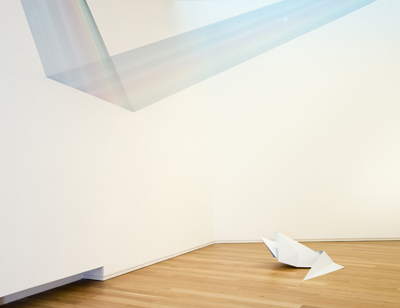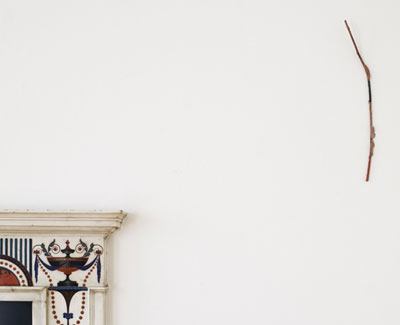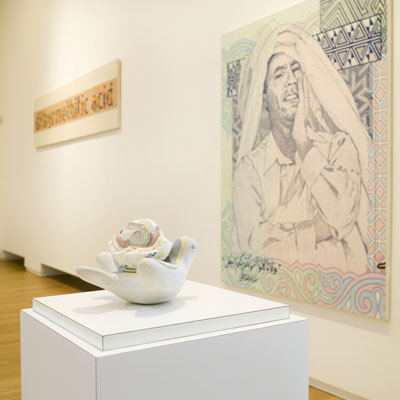
We are told this exhibition deals with the examination of the disparate nature and frequency of life, something immediately evident in the eclectic nature of the artists involved. Hayley Tompkins examines the minutiae of life through a suite of delicate, subtle works that take time to examine. By contrast, Mark Garry and Pádraig Timoney play by their own rules, extravagantly moulding life about them. Curator Michael Dempsey taps into the multi-frequency of art today, contrasting it against the canonical, singular resolve of the art institution.

Tomkins has created works in response to the other pieces on show and works as the antithesis to much of the later work by Garry and Timoney. Mixed–media works such as Variations, 2008, examine the fragmentary nature of life in the twenty-first century. Shards of metal inscribe a scarification upon the piece, while remnants of forcibly removed segments remain as scabs. Tomkins’ paintings exhibit the remains of a very modern battle. Bolts serve as bullet holes on the block surfaces, each piece scrubbed over to a metallic sheen; garish in its odd placement, connotations of industrial struggle and tank warfare abound. These works speak to our continual struggle with and reliance upon materiality, the sheen of metal reminiscent of hard cash. Photos remain as ripped edges, a humanity lost to metallurgy, the ancient alchemical rub showing through.
Tompkins’ sculptural works are delicate yet powerful. Metabuilt, 2009, consists of a twig crudely adorned with tiny images of everyday life, including a TV, with rabbit ears atop, perched at one end. The world seems to be miniaturised. The images, though attached, seem flimsy and likely to fall off. Is Tomkins suggesting our attachment to modernity is frivolous? Is this a divining rod for technological advancement?
Tomkins also shows a filmic piece, Interstice, 2008 (4min). The blinking of an artificial life made beautiful, it’s all a matter of how one sees things; the sublime nature of a life viewed through the artist’s eye. Minimalist structures evanesce on screen, created by what appears to be shots of techno-hardware. A Kantian pure judgement of beauty resonates though the work.
The theme of resolution through art and nature resounds within the entire installation. Mark Garry’s This is about you, 2007, consists of three works: a diminutive sketch in pencil of a tree, an installation made up of different coloured threads, converging and diverging at three main points upon the gallery wall, and a grounded sculptural piece. The threaded work brings the environment into sharp focus. The threads, acting as light, seem to funnel the exterior light from the gallery window into the space, refracting off the walls; one is conscious of the space outside in relation to the interior.
Moving through the piece and under the work we become incorporated, implicit to the creation of art. Garry ideologically diverges from Tomkins in this respect; the focus here is on the Bergsonian body. Coming together at concentrated points, the threads remind us of the power of colour. At other points the threads diverge so far as to appear white against the backdrop of the gallery wall. The natural resonator that is light becoming elemental resonates well with the solidity of forms witnessed in the first two rooms. The enlarged origami swan sculpture is anachronistic and languid below the threads; it points to the ephemeral nature of life, the permanently bowed head suggesting death in beauty. The tree sketch placed demurely to one side suggests the futility of representation, the futility of art in its struggle to recreate the sublime.

A multitude of disparate works by Pádraig Timoney fill two rooms within the exhibition. Mingling painting, sculpture, photography and mixed–media works, Timoney creates the ideal guerrilla–artist statement – as much as one can in the confines of the gallery. Please touch, 2007, is a work made of pewter and aluminium with a clenched golden fist pushing into the gallery space. Above the fist, ‘Please Touch’ sheens in etched metal letters. One doesn’t know whether to take him at his word and touch the clenched fist or to defer to gallery practice and ignore. The material here is unavoidable and the uncanny hand does make one shrink from being near it in fear of it actually grasping for you. The illusionistic lettering confuses all the while illustrating the uncertainty of aesthetic judgement alone. Is the link between eye and brain to be trusted? In this respect, the judgement of art is being examined in each of the artist’s works.
Timoney has many untitled pieces throughout, described only through the referencing of material. In a painting split in two, one side depicting a ship, the other a confused referencing of the ship, the paint appears to have been allowed run around the canvas, the controlled hand of the artist has given way to the rule of material. My favourite Timoney piece is a pottery bird anchored by the heavy weight of a part-munched, giant gob-stopper. This piece, hilarious in its absurdity, forebodes a loss of innocence. For Timoney, I feel, art is a constant investigation, a play that should not be made formulaic; as such his work feels uneasy within the gallery space.

The final room shows two of Garry’s works; they make up Logic and its associates, 2009. The first piece comprises two componiums affixed to the handles of what looks like an antiquated hardwood treadmill. We are told each music box represents the head and the heart. The cut-out dots that move through the mechanism, creating the music as the cogs turn, follow a pattern associated with wave readings taken from the brain and heart. Thus both machines produce concurrent heart and brain rhythms, and when played in tandem the music created is quite harmonious. The monumental importance of the body–as–whole is referenced. One imagines the componiums ticking away as we frantically walk, though the thread of paper running through them is already well used, hole-punched into near oblivion.
The second piece is Calderesque in its mobile simplicity, though this piece is stationary, affixed to the wall and reminiscent of a sun–dial, referencing light once again. We are told this piece represents a leaf; the Naturalist ideal is implicit – ‘all basic truths are truths of nature’ – and of course Naturalism also proposes that methods of science should be used in philosophy.
One leaves the exhibition hopeful of what nature holds. We are reminded that life would be impossible without the resonating hum of frequencies that make up our world. The artists here propose that to remain in harmony with the frequency of nature is ultimately a matter of survival.
Hilary Murray is a critic and Masters student at NCAD.